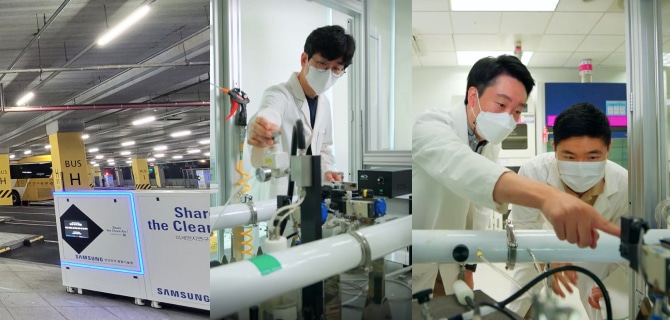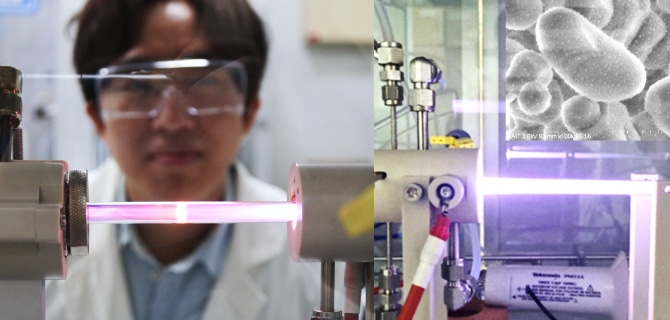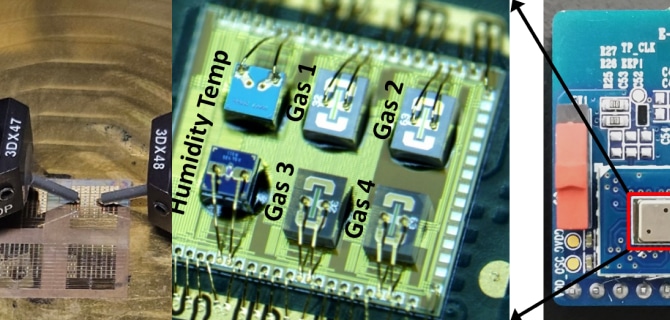In the pursuit of a sustainable future, the development of innovative environmental technologies is of paramount importance. At the forefront of this endeavor, SAIT is committed to creating eco-friendly source technologies that address critical environmental challenges, including air pollution, greenhouse gas emissions, and energy consumption. These solutions align with Samsung Electronics‘ commitment to ESG management and to fostering a cleaner and more sustainable world.
Currently, air pollution reduction technologies are imperative for tackling global environmental challenges, including air quality degradation and climate change, and for ensuring the sustainable advancement of national industries. Advanced systems like filtration units, scrubbers, and catalytic converters are being deployed; however, these technologies face significant obstacles related to efficiency, technical reliability, and cost-effectiveness.
- 1-1. Particulate Matter Diagnostics/Removal
Particulate matter (PMs), especially particles smaller than 2.5㎛, and precursor gases have detrimental effects on public health and semiconductor manufacturing processes. Additionally, as semiconductor circuits become smaller and more complex, managing airborne molecular contamination (AMC), which causes defects during manufacturing, is crucial for new semiconductor manufacturing facilities.
Therefore, we aim to identify the critical issues of PMs and AMCs to provide technical solutions for society and boost business competitiveness. We are conducting research on (1) developing advanced air purification technologies to improve the surrounding air quality, (2) the formation of secondary particles from emission sources, and (3) AMC dispersion simulation to facilitate its prompt identification with Al techniques at a semiconductor FAB.
- 1-2. FAB Emission Reduction
Since Samsung Electronics announced our New Environmental Strategy in 2022, the ASRC has been dedicated to advancing technologies that efficiently decompose and treat key pollutants, including nitrogen oxides (NOx) and total hydrocarbons (THCs) as FAB emissions, and perfluorocarbons (PFCs) and nitrous oxide (N2O), which are significant greenhouse gases emitted by semiconductor manufacturing facilities.
Based on our expertise in high-performance catalysts, chemical reaction systems, and low-power plasma technology, we are committed to advancing our environmental management practices. By developing and deploying innovative energy-efficient technologies that integrate these core competencies, we aim to implement them at FAB sites, thereby contributing to sustainable industrial operations.
Carbon dioxide (CO2) concentrations in the atmosphere have significantly increased because of human social activities. To address these concerns, diverse efforts to reduce CO2 emissions have been made in all sectors of society. Carbon capture has been extensively studied as a technology to reduce carbon dioxide directly. Technologies such as absorption, adsorption, and membranes have been studied mainly in academia; however, the development of more effective and energy-intensive technologies is necessary for a sustainable future. In addition to point-source CO2 capture technologies, the deployment of large-scale negative-emission technologies is vital.
SAIT is devoting efforts from the materials and engineering perspectives not only to stationary CO2 capture but also to directly capturing CO2 from ambient air or direct air capture. Meanwhile, post-treatment of captured CO2 is also important for generating a closed loop of carbon, through either utilization in value-added products or permanent storage. SAIT is also paving the way for effective CO2 utilization using catalysts and electrochemical systems.

To mimic human olfaction, state-of-the-art technical innovations are currently being applied, such as materials that are sensitive and selective to various odors, sensor arrays, interface ICs, signal-processing blocks, and artificial neural networks (ANN) or neuromorphic classifiers.
We aim to integrate all the related technologies for olfactory sensing. This includes developing materials that provide the beginning of a signal change in response to odor molecules, developing sensitive transducers, designing dedicated read-out ICs that digitize the analog responses of sensors, and preprocessing that removes unwanted signals. Using hundreds of multiarray sensors where all of these core technologies are integrated, we are aiming to enable affordable, robust odor recognition devices for commercial applications.
This miniaturized olfactory sensor can make our lives safer by detecting our surroundings more accurately. Beyond the level of human olfaction, we ultimately want to benefit the world by innovating conventional disease diagnostic technologies.

The global transition to sustainable economies relies heavily on the adoption of green energy such as clean fuels (green hydrogen or e-fuels) produced electrochemically using renewable energy sources without carbon dioxide emissions. Green hydrogen refers to hydrogen produced by electrolyzing water using renewable electricity and can be used for e-fuel production with green CO from direct-air captured CO2 electrolysis.
We are researching new core technologies to cover the entire green energy value chain from production, storage, and transport to applications for successful commercialization. We are developing solutions for viable green energy by focusing on material design, electrode microstructure/interface engineering, and the control of thermoelectric reaction kinetics to drive the sustainable green energy economy forward.
